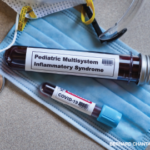 ACR CONVERGENCE 2021—So many elements of the past two years have been, to put it mildly, unusual given the effects of the COVID-19 pandemic. Perhaps equally strange have been the discoveries related to understanding how the SARS-CoV-2 virus functions, what leads to mild or severe disease in different patients and what implications these findings hold for the field of rheumatology. Mariana Kaplan, MD, chief of the Systemic Autoimmunity Branch of the National Institute of Arthritis and Musculoskeletal and Skin Diseases (NIAMS), National Institutes of Medicine (NIH), Bethesda, Md., moderated Day 2 of the Basic and Clinical Research Conference focused on Rheumatology Complications of Emerging Viral Infections/SARS-CoV-2.
ACR CONVERGENCE 2021—So many elements of the past two years have been, to put it mildly, unusual given the effects of the COVID-19 pandemic. Perhaps equally strange have been the discoveries related to understanding how the SARS-CoV-2 virus functions, what leads to mild or severe disease in different patients and what implications these findings hold for the field of rheumatology. Mariana Kaplan, MD, chief of the Systemic Autoimmunity Branch of the National Institute of Arthritis and Musculoskeletal and Skin Diseases (NIAMS), National Institutes of Medicine (NIH), Bethesda, Md., moderated Day 2 of the Basic and Clinical Research Conference focused on Rheumatology Complications of Emerging Viral Infections/SARS-CoV-2.
Pathophysiology of COVID-19
The featured speaker in the session was Dennis McGonagle, FRCPI, PhD, head of experimental rheumatology at the Leeds Institute of Rheumatic and Musculoskeletal Medicine, St. James Hospital, University of Leeds, U.K. Dr. McGonagle discussed the distinctive form of pulmonary immunovascular thrombosis that is seen with COVID-19 disease and how the pathophysiology of disease has come to be understood over time.
He pointed first to a letter to the editor published in The Lancet on March 16, 2020, that has since been cited over 6,000 times. In the correspondence, Mehta and colleagues noted how treatments for COVID-19 had been focused on antiviral therapy and supportive care, but that hyperinflammation seems to play a large role in severe disease and, thus, immunosuppression should be considered as part of the treatment regimen for this cytokine storm-like entity.1
Indeed, Mehta et al. referenced a retrospective, multi-center study of 150 confirmed COVID-19 cases in Wuhan, China, that indicated how elevated ferritin and interleukin-6 (IL-6) levels were predictors of increased mortality, thereby implying that virally driven hyperinflammation may significantly contribute to the risk of death.2 This hypothesis subsequently led to the use of corticosteroids and IL-6 inhibition with medications like tocilizumab as part of the treatment of COVID-19.
Dr. McGonagle acknowledged that entities like cytokine release syndrome in macrophage activation syndrome (MAS) or in cases of chimeric antigen receptor (CAR)-T cell therapy appear similar to the forms of organ failure seen with severe COVID-19, but he identified discrepancies in the lab results seen in these conditions. For instance, severe cytokine storm will generally demonstrate IL-6 levels up to 10,000 pg/ml and ferritin levels close to 100,000 μg/L. In studies looking at these biomarkers in COVID-19, levels appear much lower, with IL-6 levels in severe COVID-19 disease reaching only 10% of the usual elevation seen with cytokine release syndrome associated with CAR-T cell therapy.
Diffuse Pulmonary Intravascular Coagulopathy
Dr. McGonagle next discussed work that he and his collaborators have published evaluating the lung-restricted vascular immunopathology in COVID-19 pneumonia. MAS, or secondary hemophagocytic lymphohistiocytosis, involves an acute consumptive coagulopathy that leads to disseminated intravascular coagulation (DIC). In severe COVID-19, lung pathology demonstrates significant microvascular thrombosis and hemorrhage linked to extensive alveolar and interstitial inflammation that has a MAS-like appearance.
Dr. McGonagle and colleagues thus coined the phrase diffuse pulmonary intravascular coagulopathy to refer to this process, which in its early stages is distinct from DIC. Because coronaviruses often show tropism for angiotensin-converting enzyme 2 on type II pneumocytes, which are adjacent to much of the pulmonary vascular network, this may explain the appearance of diffuse pulmonary intravascular coagulopathy in patients with severe COVID-19 disease, particularly in the context of the intense multifaceted inflammatory reaction seen in such patients.3
Dennis McGonagle, FRCPI, PhD, discussed the distinctive form of pulmonary immunovascular thrombosis that is seen with COVID-19 disease & how the pathophysiology of disease has come to be understood over time.
Role of Anticoagulation
In discussing the implications of pulmonary intravascular coagulopathy, Dr. McGonagle explained that the role of anticoagulation continues to be of extreme interest. Two large trials have been published this past year in The New England Journal of Medicine evaluating the effects of therapeutic anticoagulation with heparin in patients with COVID-19. In one study, researchers used an open-label, adaptive, multiplatform, controlled trial design to randomly assign hospitalized, non-critically ill patients with COVID-19 (i.e., patients without need for critical care-level organ support at enrollment) to receive either therapeutic-dose anticoagulation with heparin or usual-care pharmacologic thromboprophylaxis.
The primary outcome was organ support-free days, evaluated using a scale that combined in-hospital death and number of days free of cardiovascular or respiratory organ support up to day 21 in patients who were ultimately discharged from the hospital. Among 2,219 patients, therapeutic-dose heparin or low molecular weight heparin (LMWH) appeared to increase the probability of survival to hospital discharge with a reduced need for organ support (with an adjusted absolute between-group difference of 4%; 95% confidence interval of 0.5% to 7.2%), though with more major bleeding with heparin or LMWH treatment than with thromboprophylaxis (1.9% vs. 0.9%).4
In contrast, a trial using the same design that was conducted among 1,098 patients who were critically ill with COVID-19 concluded that therapeutic-dose heparin or LMWH did not improve the primary outcome of days without organ support as compared to usual care pharmacologic thromboprophylaxis. Moreover, use of therapeutic-dose heparin or LMWH was associated with more major bleeding complications than usual-care prophylaxis (3.8% vs. 2.3%).5
What accounts for this difference in effects of anticoagulation in critically ill versus non-critically ill patients? In severe COVID-19, it appears that thrombus formation is driven by a cascade of cytokines and other proinflammatory products that produce surface-bound complexes and fibrin-bound thrombin. These complexes are very resistant to inhibition by antithrombin, the key cofactor in heparin and LMWH. Because formation of such complexes may be reduced in patients with moderate disease, this could explain the potential benefit of thromboprophylaxis in non-critically ill patients compared to the lack of benefit in critically ill patients with COVID-19.6
Vasculitic Features of COVID-19
Dr. McGonagle also discussed his group’s work on the vasculitic features of COVID-19 disease. Some patients with asymptomatic or mild COVID-19 have demonstrated a mild cutaneous vasculitis that is associated with a robust immune response, typically seen in otherwise healthy young patients. This cutaneous vasculitis, which has a predilection for the toes and represents the entity that has colloquially been called “COVID toe,” shows significant type I interferon (IFN) production and occurs in the context of an intact anti-SARS-CoV-2 immunity.
In other patients with non-severe infection, either classical Kawasaki disease or Kawasaki-like disease in the form of multisystem inflammatory syndrome of children (MIS-C) and of adults (MIS-A) can occur, with MIS-C and MIS-A showing prominent cardiac muscle involvement and the absence of coronary aneurysms. Certain patients may manifest myocarditis as part of the Kawasaki phenotype but others may have myocarditis independent of other features of Kawasaki disease.
Finally, several vasculitis mimics seen with COVID-19 are mediated by pulmonary intravascular coagulopathy, hypoxemia, pulmonary hypertension and systemic venous thromboembolism. Importantly, Dr. McGonagle explained that postmortem findings in patients with COVID-19 have revealed a novel site of thrombosis in the pulmonary venous territory (distal to the alveolar capillary bed) and that this can serve as a nidus for systemic microembolism.7
IFN Pathway
After Dr. McGonagle’s talk, several abstracts were presented to further explore the pathophysiology and implications of COVID-19 disease. Timothy Niewold, MD, Judith and Stewart Colton Professor of Medicine and Pathology and director of the Colton Center for Autoimmunity at New York University, discussed the IFN pathway and its links to both lupus and to attenuation of acute COVID-19. Dr. Niewold explained that certain gain-of-function IFN pathway alleles seem to increase the risk of systemic lupus erythematosus (SLE) but may also provide protection against certain viral infections (indeed, such protective effects could explain why these alleles persist in the general population).
Dr. Niewold’s group hypothesized that common gain-of-function IFN pathway SLE risk alleles would be associated with protection from mortality in acute COVID-19. The group collected genomic data from 1,149 COVID-19 positive patients and studied single nucleotide polymorphisms in IFN pathway genes in which gain-of-function properties in humans have been previously reported. They then compared in-hospital mortality from acute COVID-19 between genotype groups for the various IFN pathway SLE risk alleles. The findings of the study indicate that a number of IFN pathway lupus risk alleles significantly impact mortality following COVID-19 infection, with certain alleles showing associations with decreased risk of mortality in patients with these alleles compared to patients without these alleles.
These findings have led to two important outcomes: 1) the development of multivariate prediction models that combine genetics and known biomarkers of disease severity to accurately predict mortality in acute COVID-19, and 2) an appreciation for how type I IFN pathway risk alleles for autoimmune disease may persist in high frequency in humans due to immune system benefits in protecting against viral infections.
New-Onset IgG Autoantibodies
The subsequent abstract was presented by Sokratis Apostolidis, MD, rheumatology fellow at the University of Pennsylvania in Philadelphia, on the subject of new-onset IgG autoantibodies detected in patients hospitalized with SARS-CoV-2 infection. After several early reports indicating the presence of potential autoreactivity in COVID-19 patients, Bastard and colleagues showed that greater than 10% of a cohort of patients with life-threatening COVID-19 pneumonia had neutralizing IgG autoantibodies against IFN.8
With this in mind, Dr. Apostolidis and colleagues sought to provide a reference map for common autoantibodies and anti-cytokine antibodies in patients with moderate to severe COVID-19 and to examine the extent, breadth and de novo generation of these autoantibodies.
Their study found that 49% of patients had at least one connective tissue disease-associated autoantibody (the prevalence of these autoantibodies in healthy controls was 13%) and that 89% of patients with moderate to severe COVID-19 had at least one anti-cytokine autoantibody, with type I IFN being the most common target.
In the question and answer segment of the talk, Dr. Apostolidis noted that it is unclear if such autoantibody production is entirely unique to COVID-19 or if similar processes occur with other viral infections. He explained that we now have a wealth of information on this subject for the SARS-CoV-2 virus, but that one future direction for research should be to expand such studies to other viral infections.
He also stated that we do not yet have the longitudinal data to see what happens to these autoantibodies in patients over time. It remains to be seen if the formation of new-onset IgG autoantibodies in moderate to severe COVID-19 has implications for future development of immunodeficiency phenotypes or autoimmune disease in these patients.
MIS-C
The next talk was given by Kate Webb, MD, PhD, pediatric immunology clinician scientist at the University of Cape Town, South Africa, on the topic of SARS-CoV-2 antibody phenotype and immune gene expression in MIS-C. Dr. Webb explained that, to date, it has been unclear why some children with SARS-CoV-2 infection develop MIS-C while others do not. The aims of the study conducted by Dr. Webb and colleagues were to compare a cohort of children with evidence of exposure to SARS-CoV-2 and see which patients develop MIS-C, to look for differences in SARS-CoV-2 antibodies and to evaluate differences in immune gene expression among these patients.
Researchers enrolled 33 children with MIS-C (mean age 6.9 years) and compared these individuals to 97 healthy children (30% of whom had been exposed to SARS-CoV-2 and 60% who were unexposed). From studying these children, Dr. Webb and her colleagues noted that SARS-CoV-2 antibody titers were no different in MIS-C compared to healthy exposed children and that spike antibody (IgG) titer does not change over time in patients with MIS-C. Dr. Webb and her colleagues also found that patients with MIS-C showed a distinct expression of immune genes as compared to healthy children, with a dynamic return of gene expression to normal when followed over time.
TNFi or Rituximab Treatments
In the penultimate talk, Luisa M. Rojas Vargas, MD, Rheumatology Service of Hospital La Mancha Centro, Alcazar de San Juan, Spain, discussed a study assessing whether tumor necrosis factor inhibition (TNFi) or rituximab is related to a different course and severity of SARS-CoV-2 infection in patients with rheumatic diseases as compared to patients receiving other biologic therapies.
In this observational, retrospective, multicenter study, Dr. Vargas and colleagues enrolled 372 patients with rheumatic diseases who had received TNFi or rituximab from at least three months prior to the beginning of the COVID-19 pandemic until March 2021. Of these patients, 18% had confirmed SARS-CoV-2 infection, with 40% of these patients having a history of spondyloarthritis, 32% with rheumatoid arthritis and 12% with psoriatic arthritis.
For treatments, 66% had received TNFi and 13% had received rituximab. Of the 68 total patients with SARS-CoV-2 infection, 31% developed pneumonia and 25% were admitted to the hospital. Mean time of hospitalization was 25.1 days and 3% of patients with SARS-CoV-2 infection did not survive.
Dr. Vargas noted that patients who had been receiving TNFi therapy for their rheumatic disease had lower rates of pneumonia and hospitalization, fewer days of hospitalization, lower World Health Organization (WHO) scale of severity of COVID-19 disease and lower mortality (0%) as compared to patients receiving other biologic therapies.
In contrast, patients who had been receiving rituximab had higher rates of pneumonia, hospitalization and WHO scale of severity of COVID-19 disease as compared to patients receiving other biologic therapy. An additional important finding from this study was that, although 100% of patients on TNFi developed SARS-CoV-2 IgG positivity after infection, 0% of patients receiving rituximab developed such antibodies.
Outcomes for Anakinra Treatment
In the final abstract presentation, Shirkhan Amikishiyev, MD, Department of Rheumatology, Faculty of Medicine, Istanbul University, Turkey, discussed predictors of outcomes for anakinra treatment in COVID-19 patients with MAS. For this study, records were reviewed for adult patients hospitalized with COVID-19 between March 2020 and May 2021.
From this group, patients were identified as having COVID-19 related MAS based on expert opinion and a scaled score created by the research group evaluating the probability of MAS using typical features (i.e., fever, ferritin >550 ng/ml, neutrophilia >6000 cells/mm3, lymphopenia <1000 cells/mm3, etc.).
From within this group, the patients who received anakinra treatment constituted the study cohort, and a total of 218 such patients were identified. Overall, it appears that patients who received anakinra earlier in the course of hospitalization fared better and that decreases in C-reactive protein (CRP), ferritin and D-dimer and increases in lymphocyte count were associated with improved outcomes.
In contrast, increased D-dimer and troponin were associated with worse outcomes, possibly indicating the presence of cardiovascular and thrombotic pathologies that did not respond to anakinra. Finally, unlike in patients treated with tocilizumab, change in CRP was found to be a helpful biomarker to follow in evaluating efficacy of anakinra treatment.
The session as a whole was tremendously interesting and insightful, and much remains to be understood about the pathogenesis of severe COVID-19 disease. As was clear from the presentations, the field of rheumatology has accepted the challenge of seeking to understand this complex condition. If there is a silver lining to the pandemic, perhaps it is that understanding SARS-CoV-2 will lead to a better understanding of other viral pathologies for autoimmune disease and of the complicated machinery of the immune system as a whole.
These are strange times we are living in, but hopefully the night is darkest just before the dawn.
Jason Liebowitz, MD, completed his fellowship in rheumatology at Johns Hopkins University, Baltimore, where he also earned his medical degree. He is currently in practice with Skylands Medical Group, N.J.
References
- Mehta P, McAuley DF, Brown M, et al. COVID-19: Consider cytokine storm syndromes and immunosuppression. Lancet. 2020 Mar 28;395(10229):1033–1034.
- Ruan Q, Yang K, Wang W, et al. Clinical predictors of mortality due to COVID-19 based on an analysis of data of 150 patients from Wuhan, China. Intensive Care Med. 2020 May;46(5):846–848.
- McGonagle D, O’Donnell JS, Sharif K, et al. Immune mechanisms of pulmonary intravascular coagulopathy in COVID-19 pneumonia. Lancet Rheumatol. 2020 Jul;2(7):e437–e445.
- ATTACC Investigators, ACTIV-4a Investigators, REMAP-CAP Investigators, Lawler PR, et al. Therapeutic anticoagulation with heparin in noncritically ill patients with Covid-19. N Engl J Med. 2021 Aug 26;385(9):790–802.
- REMAP-CAP Investigators, ACTIV-4a Investigators, ATTACC Investigators, Goligher EC, et al. Therapeutic anticoagulation with heparin in critically ill patients with Covid-19. N Engl J Med. 2021 Aug 26;385(9):777–789.
- Ten Cate H. Surviving COVID-19 with heparin? N Engl J Med. 2021 Aug 26;385(9):845–846. Erratum in: N Engl J Med. 2021 Sep 9;385(11):1056.
- McGonagle D, Bridgewood C, Ramanan AV, et al. COVID-19 vasculitis and novel vasculitis mimics. Lancet Rheumatol. 2021 Mar;3(3):e224–e233.
- Bastard P, Rosen LB, Zhang Q, et al. Autoantibodies against type I IFNs in patients with life-threatening COVID-19. 2020 Oct 23;370(6515):eabd4585.







